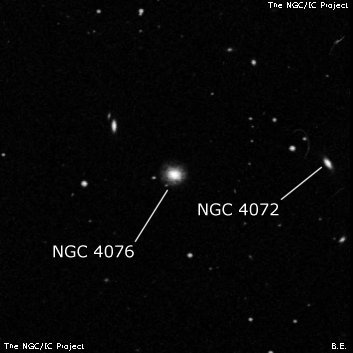
William Herschel discovered NGC 4076 = H III-396 = h1075 on 27 Apr 1785 (sweep 403) and recorded "Six nebulae. The times and numbers belong to the three first [III-391, III-392 and III-393]..." The three nebulae [10 to 12'] to the south, which he did not measure positions, are likely NGC 4061, NGC 4065, and NGC 4076 (three brightest). John Herschel recorded this galaxy on 24 Feb 1827 (sweep 59). He simply noted "the last of 5." and equated it with H III-396. His position as 2.7' too far south-southeast.
Ralph Copeland, observing with LdR's 72" on 3 Apr 1872, notes "south following these nebulae NGC 4061, 4065 and 4072] are two others, F, L, R, glbM and eF, L, R, lbM, pos 47.6°, Dist 133.6". The last pair refers to NGC 4076 and PGC 213924.
400/500mm - 17.5" (3/28/87): faint, fairly small, slightly elongated, diffuse. Located within the NGC 4065 cluster and the eighth galaxy in the field. LEDA 213924 lies 2' NE and appeared very faint, very small, round. Forms a right angle with NGC 4076 2.1' SW and a mag 13 star to the SE.
600/800mm - 24" (3/22/14): fairly faint, fairly small, round, 30" diameter, small slightly brighter core. Located 6.5' ESE of NGC 4065 (close pair with NGC 4061). NGC 4072 lies 4.4' W.
Notes by Steve Gottlieb